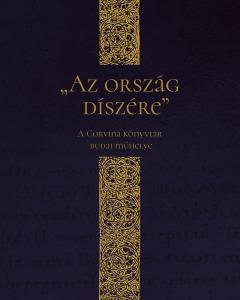
“To the ornament of the country”. The Corvina Library and the Buda Workshop
“To the ornament of the country”. The Corvina Library and the Buda Workshop
Exhibition Catalog
Edited by Edina Zsupán
National Széchényi Library, Budapest, 2020
488 pages
ISBN 978-963-200-710-6
Corvinas are not only museum treasures of European cultural history but they are also relevant, living elements of Hungarian historical consciousness, which, with the enrichment of research methods and results, with the changes of the cultural environment, provide opportunities for a plethora of new interpretations. Their being symbolic and cult-like has an extremely strong collection organizing role. They might have played a role in the Hungarian national library being moved to the Buda Castle in 1985, as the onetime library of King Matthias Hunyadi was also located there, so the corvinas could literally return to their former home.
This symbolic function, the enchanting effect of these cult objects could be experienced “in action” at the exhibition entitled The Corvina Library and the Buda Workshop, held in National Széchényi Library from November 6, 2018 until February 10, 2019. The event was another important stage of exploration and interpretation.
The possibilities of scientific interpretation are not independent of the current state of research. Modern-era corvina research goes back to approximately 150 years. Major task of the first period of research was stock reconstruction: it had to be established and collected where corvinas had been kept all over the world. The main consideration during that phase was sorting. The main purpose of a previous corvina exhibition held in 1990 was to show that these important codices have survived and still exist. The next exhibition held in 2002 under title Kings and Corvinas has already highlighted the relationship between royal representation and the library, in line with the international directions of Renaissance codex research. This is when the complex corvina program was launched, which has brought a good many Hungarian and international academic achievements.
The professional catalog accompanying the exhibition explores, in a monographic way, the issue of the book-making workshop established in Buda during the reign of King Matthias. At the same time, it discusses the entire Corvina Library, clarifying the individual phases of its creation and the time when the library was set up, and separating the source of each library section. It discusses in detail the Buda workshop itself. Its basic premise is that the tension arising from the distance of the library, which intended to follow Italian patterns, from Italy, proved to be of decisive importance. Such a consequence was the relatively low number of Italian illuminators arriving in Hungary, the nature of the cooperation between them, and the high importance of imitation. The latter was due to a number of circumstances. Partly due to the limited availability of models of Renaissance-style book painting, but the special hierarchy of the workshop also played a major role in it, in the name of which the smaller masters imitated the work of their more prestigious staff and predecessors. All this was not independent of a certain unifying intention that wanted to unify the items of the Buda library inside and out. By recognizing the principles, it became possible to separate the works made in Buda (miniatures, additions, complete volumes) and the items of Italian origin. It has been known for a long time that illustrated codices had been made in the royal workshop not only for the royal couple but also for high priests and members of the royal administration. Compared to previous important but segmented research results, it can be considered a significant conceptual change that, for the first time, the exhibition has integrated these items, in the greatest number and fullest depth, into the closest possible context of the Corvina Library and the Buda workshop.
Critical study of previous research results, presentation of the latest academic achievements and the subtlest ever elaboration on the workshop not only reflect current research results, but we do hope that it can also serve as another starting point of a more complete exploration of the Corvina Library and the written culture of humanism in Hungary.
Studies included in the book
- László Szörényi: Megnyitóbeszéd (Opening speech)
- Edina Zsupán: A budai műhely (The Buda Workshop)
- Árpád Mikó: Konstrukció és rekonstrukció – Adalékok a Corvina budai műhelyének historiográfiájához (Construction and reconstruction – Contributions to the historiography of the Buda workshop of Corvinas)
- Mario Marubbi: Francesco da Castello pályafutása (Francesco da Castello’s Career)
- Marianne Rozsondai: A magyarországi könyvkötések reneszánsz korszaka (The Renaissance era of book bindings in Hungary)
- András Németh: A Corvina görög nyelvű kódexeinek restaurálása Budán (Restoration of the Greek-language codices of the Corvina Library in Buda)
- Péter Ekler: Ptolemaiosz és Trapezuntius: adatok Johannes Regiomontanus műveihez, valamint életének magyarországi szakaszához (Ptolemy and Trapezuntius: data to Johannes Regiomontanus’ works and the period of his life spent in Hungary)
- Anna Boreczky: Történetírás és könyvkultúra Mátyás király udvarában. A „budai műhely” verzójára (Historiography and book culture in the royal court of King Matthias. On the verso of the “Buda Workshop”).
Shopping
Our publications are available in our bookshop, or can be ordered from the Publications Department of the NSZL using the contact details below: Főigazgatói Kabinet kiadványtára, Országos Széchényi Könyvtár, 1276 Budapest P.O. box 1205., phone: 06-1-23-23-506, e-mail: kiadvanytar@oszk.hu.




